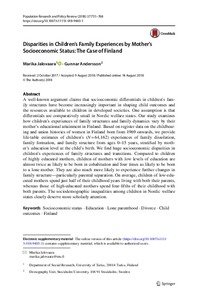Disparities in children's family experiences by mother's education: The case of Finland
Jalovaara Marika; Andersson Gunnar
https://urn.fi/URN:NBN:fi-fe2021042719508
Tiivistelmä
A well-known argument claims that socioeconomic differentials in children’s family structures have become increasingly important in shaping child outcomes and the resources available to children in developed societies. One assumption is that differentials are comparatively small in Nordic welfare states. Our study examines how children’s experiences of family structures and family dynamics vary by their mother’s educational attainment in Finland. Based on register data on the childbearing and union histories of women in Finland born from 1969 onwards, we provide life-table estimates of children’s (N = 64,162) experiences of family dissolution, family formation, and family structure from ages 0–15 years, stratified by mother’s education level at the child’s birth. We find huge socioeconomic disparities in children’s experiences of family structures and transitions. Compared to children of highly educated mothers, children of mothers with low levels of education are almost twice as likely to be born in cohabitation and four times as likely to be born to a lone mother. They are also much more likely to experience further changes in family structure—particularly parental separation. On average, children of low-educated mothers spend just half of their childhood years living with both their parents, whereas those of high-educated mothers spend four-fifths of their childhood with both parents. The sociodemographic inequalities among children in Nordic welfare states clearly deserve more scholarly attention.
Kokoelmat
- Rinnakkaistallenteet [27094]
